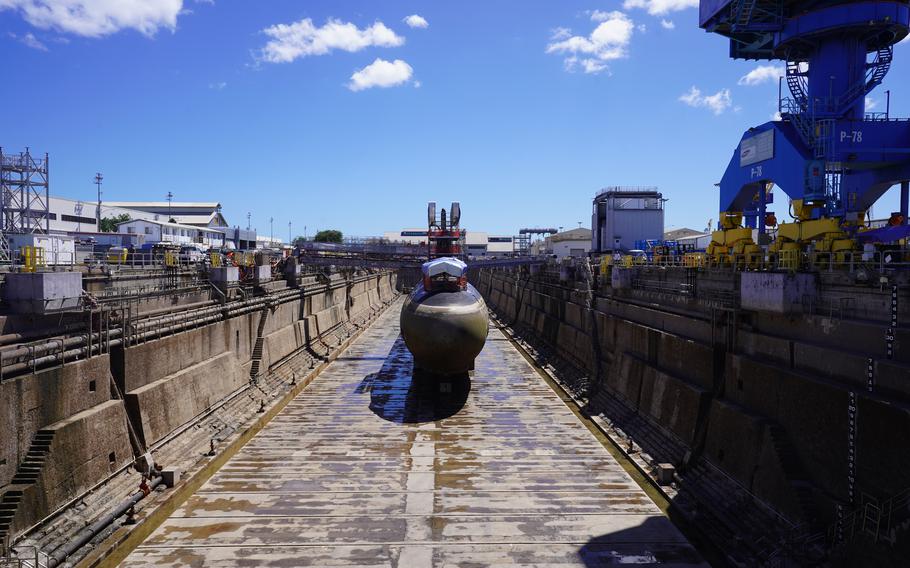
Virginia-class fast-attack submarine USS North Carolina (SSN 777) sits in Dry Dock 1 at Pearl Harbor Naval Shipyard and Intermediate Maintenance Facility on Sept. 5, 2024. (Claudia LaMantia/U.S. Navy)
HONOLULU (Tribune News Service) — The USS North Carolina fast-attack submarine pulled into a Pearl Harbor maintenance facility recently in an unprecedented situation expected to become more of a future norm.
The North Carolina, which arrived Sept. 4, joined two other Virginia-class subs at Pearl Harbor Naval Shipyard and Intermediate Maintenance Facility, marking the first time three of the Navy’s newest class of submarines are undergoing dry-dock work at the same time there, according to shipyard officials.
Four dry docks for ship and submarine maintenance exist at the facility. But one, dating to 1942, is too small and shallow to service Virginia-class subs that the Navy continues to procure as replacements for older Los Angeles-class subs in an effort to modernize more of the U.S. fleet, which includes about a dozen submarines home-ported at Pearl Harbor.
To accommodate the shift, contractors selected by Naval Facilities Engineering Systems Command are in an early stage of a $3.4 billion expansion of the shipyard with a new dry dock expected to be finished in 2028.
“To maintain the number of Virginia-classes we have in Pearl Harbor, we do need all four dry docks to be at full capacity for a number of years in the future, to keep them maintained correctly,” Capt. Richard Jones, then-commander of the shipyard, said in February as major construction on the new dry dock’s perimeter began in the water next to the outdated dry dock that will be closed after retirement of the last Los Angeles-class sub.
Capt. Ryan McCrillis, current commander of the shipyard, said in a statement that the level of current maintenance work stems from scheduled warship needs and that it brings out the facility’s mission to be the best.
“This is where the No Ka Oi shipyard’s mission comes to life,” he said. “Our shipyard team of civilians and Sailors, working with each ship’s crew, accomplishes everything needed to keep the fleet fit to fight.”
Work on the North Carolina, SSN 777, is being done in Dry Dock 1. Two other Virginia-class subs, the USS Illinois and USS Colorado, are undergoing work in Dry Dock 2.
There is also an Arleigh Burke-class guided-missile destroyer, the USS Hopper, DDG 70, in Dry Dock 4.
Dry Dock 3 remains functional but cannot handle Virginia-class subs or larger surface ships.
The duration of work varies by vessel but averages two to three years and often includes structural inspections and repairs, replacing complex mechanical and electrical systems, nuclear work and new paint or other coatings.
The Illinois, SSN 786, was commissioned in 2016 and home-ported at Pearl Harbor in 2017. It entered dry dock in late 2023 after a seven-month Indo-Pacific deployment that included traveling roughly 35, 000 nautical miles under the sea. Work on this boat is estimated to cost $443 million.
The Colorado, SSN 788, was commissioned in 2018 and previously home-ported in Connecticut. Its two-year overhaul at the Pearl Harbor shipyard began in June and is estimated to cost $370 million.
Of the three submarines at the shipyard, the recently arrived North Carolina is the oldest, having been commissioned in 2008. Its overhaul is expected to cost $465 million.
According to the Navy press office, the North Carolina went on three Pacific deployments in the past six years and is approaching middle age.
“North Carolina is approaching the midway point of her planned life cycle, and it is important to conduct repairs and state-of-the-art upgrades to ensure she is combat-ready and equipped to conduct all assigned tasking well into the 2030s,” Cmdr. Tad Robbins, commanding officer of the North Carolina, said in a statement.
The Navy press office also stated that a peak period of work on the North Carolina will involve more than 600 workers daily.
Pearl Harbor shipyard is the largest industrial employer in the state, with over 6, 000 workers.
The dry-dock expansion is expected to create about 2,500 jobs through its anticipated 2028 completion date.
Meanwhile, the Navy continues to add to its inventory of Virginia-class subs. The first one was put into operation, or commissioned, in 2004, and about 22 are part of the U.S. fleet today. About another dozen are being built at a cost of about $4.5 billion each, according to an August report by the Congressional Research Service.
The U.S. submarine force, according to the report, is something that Navy and Pentagon leadership consider part of America’s top advantages over adversaries such as China and Russia and can be used to deter aggression.
In the Pacific region, China is embroiled in bitter disputes with neighboring countries over maritime territorial and navigation rights. One area of dispute is the South China Sea, a busy waterway through which as much as a third of all international trade travels and where tensions have sometimes boiled over into violent confrontations.
In the face of objections from China, the U.S. military has been conducting near-constant “freedom of navigation” operations in the Pacific. These operations have been demanding on the Navy’s fleets, and the Pearl Harbor shipyard increasingly is seen as a key repair and logistics hub to keep submarines and ships running.
(c)2024 The Honolulu Star-Advertiser
Visit at www.staradvertiser.com
Distributed by Tribune Content Agency, LLC.